March is Women’s History Month in the United States. (International Women’s Day isn’t widely observed here, although that may be changing.) For the past two years, I’ve tried to pick out a photograph in March which I thought was especially relevant to the theme of women’s history. In 2018 the focus was on education (Caliopians). Last year it was on the nursing profession (Montefiore School of Nursing, Class of 1938). This year’s photograph contains a large group of women wearing a variety of work clothes. The photo has nothing written on it. Was the building behind them a factory? What did they make there? The photo came to me from Brentwood, California, near San Francisco, but could have originated elsewhere.
There are 35 women in the group. Many seem to be friends.
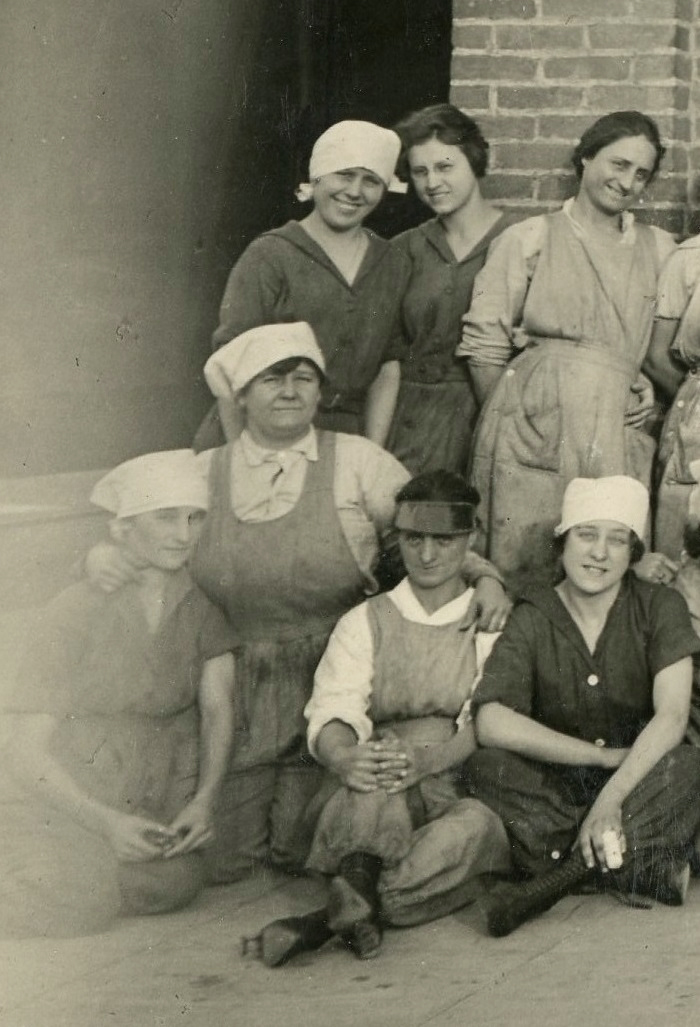




Happy Women’s Day 2020!
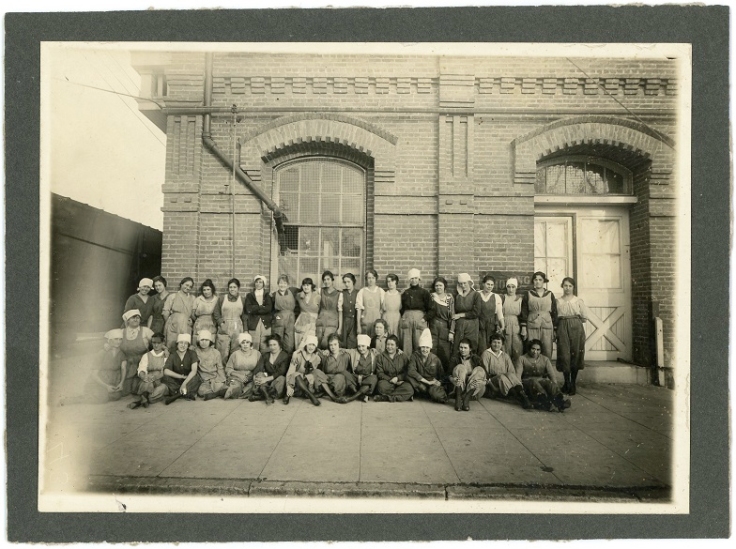
Post updated March 10, 2020.

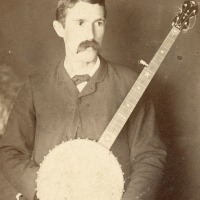
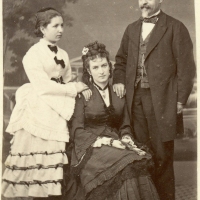
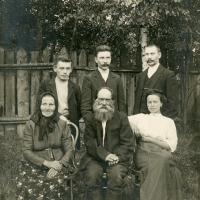
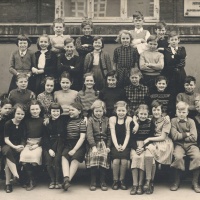
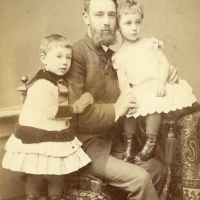
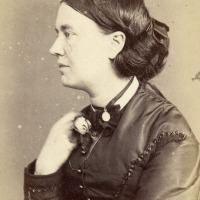
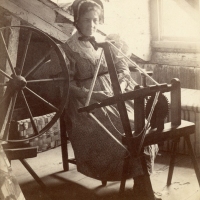
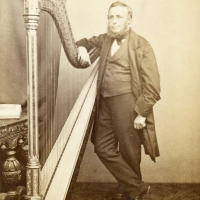
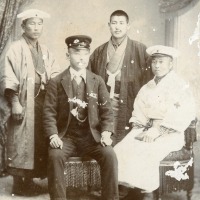
Wonderful photo, Brad! Did you try to figure out the writing on the wall? It’s likely the name of the factory where the women worked.
LikeLiked by 3 people
Thank you, Shayne! The only word I see is “Smoking,” so it was probably “No Smoking.” There’s a small red cross in the window, so there may have been a first aid station there. Those things make sense at a factory. I wish we knew more!
LikeLiked by 2 people
Unless it was a cigarette factory and they were promoting smoking!
LikeLiked by 3 people
Ha, anything is possible!
LikeLiked by 1 person
This is lovely! They feel so close knit, arms around each other, holding hands and smiling. I wonder at what all they lived through beside one another. It’s a beautiful photo to share for March. Thank you 😊🌷
LikeLiked by 3 people
Thank you, Suzanne! I love the fact that so many of them seem happy. Their working conditions must have been pretty good. There’s definitely an air of camaraderie.
LikeLiked by 2 people
This is a great find, great faces on these ladies, and such a mixed bunch of smilers and serious ones.
LikeLiked by 3 people
It’s unusual to see so many smiles in a large group photo from ANY time period. Maybe the photographer cracked a joke. 😄
LikeLiked by 2 people
Wow! Beautiful
LikeLiked by 2 people
Grazie, Sara! Some of them could be Italian. Between 1880 and 1924, more than four million Italians immigrated to America (two million between 1900 and 1910).
LikeLiked by 2 people
Sure! I like the historical photos *_*
LikeLiked by 2 people
i love this image! These look like best friends, a close-knit group of sisters.
LikeLiked by 3 people
It sort of defies the stereotype of downtrodden factory workers, doesn’t it? If indeed it’s a factory. Conditions must have varied a lot from one industry to another in the early 1900s.
LikeLike
Yes. So many comments here have mentioned how happy and close-knit they look. It’s a wonderful image, and it makes me very happy just to look at it.
LikeLiked by 3 people
I’m very glad, Carol! 🙂
LikeLike
I thought it interesting they seem to be wearing identical (and fabulous) boots. Was this fashion, or a necessity of working in that factory?
LikeLiked by 3 people
I think it was the fashion, at least for most activities, rather than a necessity. I see boots like these a lot in photos. I wonder when they became less common? That kind of information could help to date a photo like this.
LikeLiked by 2 people
I suppose there were certain types of factories that tended to employ just women as opposed to a mixed work force?
LikeLiked by 2 people
I believe that’s true, Eilene, but I don’t know which industries might employ women exclusively. That would be interesting to know.
LikeLiked by 2 people
The first thing I noticed is that many are smiling and holding hands. Hopefully it was a good place to work and they were treated well. I like the boots. Interesting that some are wearing caps. I especially like the gnomish-style cap. 😀
LikeLiked by 3 people
The gal in the gnome-cap looks like a character! She has a great big smile. I bet she had a big laugh to go with it.
LikeLiked by 1 person
I was wondering about the caps, if the women wearing them were performing a different job that the women whose heads were bare.
LikeLiked by 4 people
I wondered that as well. It’s also possible that most of them took their caps off for the photo. I doubt that, though. Would you leave your cap lying around? I don’t think so, I think they’d keep their caps with them.
LikeLiked by 1 person
Wonderful photo! It looks like they were hard working women, and proud of it. Great to share today!
LikeLiked by 3 people
Thank you, Thérèse! They do look hard-working, but they also had fun, I think. 🙂
LikeLiked by 2 people
A hospital or sanatorium, perhaps? With the red cross in one window, and what could be a bed frame in the larger window, and wire-mesh windows that can’t be opened or broken, even over the doors? Odd, too, that the windows in the doors are covered with paper. The pipe coming from the roof into the window on the left is strange; for water? Air? I’m thinking the women could be a mix of nurses, cooks, maids and other staff, as early nurses often wore aprons tied at the waist over their dresses (before uniforms). Just a guess. Intriguing photo!
LikeLiked by 4 people
Interesting thoughts! I wondered about that pipe. We may need to ask an architect. My only idea was that it might have been used for exhaust (smoke or fumes). The wire mesh I figured was to help keep people out. I never considered that it might have kept them in! The paper is also odd…. You’ve given me some new things to think about. Thank you for the great observations!
LikeLiked by 1 person
The young woman on the right in the second photo has a heavily-bandaged finger. I’m guessing she worked with machinery. I’d say some of the other women worked with machines as well, judging from how dirty their coveralls are.
LikeLiked by 4 people
Her finger is bandaged, and the other fingers on that hand look dirty. (But she’s still at work!) The dirty coveralls definitely suggest machines, although to be fair, not everyone is equally dirty.
LikeLiked by 1 person
The fact that not everyone is equally dirty is what led me to think that perhaps they had different jobs in the factory, some dirtier than others.
LikeLiked by 2 people
This is beautiful! Perfect for the day! One can feel the warmth and the sense camaraderie of the group!
LikeLiked by 1 person
Thank you, Rethy! Is Women’s Day celebrated where you live?
LikeLike
Oh yes! I live in Vietnam and here Women’s Day is celebrated in a big way.
LikeLiked by 1 person
How interesting! It isn’t really observed here, but it may catch on as a day to celebrate women’s accomplishments.
LikeLike
I love the sense of camaraderie in this photo.
LikeLiked by 1 person
I read somewhere that women showed their friendship in more demonstratively physical ways in the 19th century and early 20th, through hand-holding and such. I guess younger girls still do that sometimes.
LikeLiked by 1 person
This is such a great picture. Hope you can find out more. Wouldn’t it be great to find an ancestor in a group pic like this?
LikeLiked by 1 person
Definitely! Whenever someone in a photo I buy is identified, I try to track down possible descendants. They don’t always respond to my messages, and some are suspicious of my motives, but most are very appreciative.
LikeLiked by 1 person
So nice of you to do that. I’d love a message like that.
LikeLiked by 1 person
The item to the left of the foto looks like a boxcar, which would mean that the building has a railway yard/siding. The building itself could belong to a railway company, but many industries had their own access to the railway at that time. The architecture for the building is quite distinctive and, if a railway company, would have been part of a company style and easily identifiable to that company. It all depends on finding somebody who has that kind of knowledge.
The biggest clue is the sign next to the door. While I agree that it reads “moking”, I disagree that there is an “s” before that. There’s not much space and any letter would have to be quite narrow. Besides, were signs regulating smoking common years ago? But I’m at a blank over what it could say otherwise.
LikeLiked by 2 people
Hmm, I’m also at a loss as to what else the word could be. I do think smoking was regulated in some places, such as factories, not for health reasons but because of the fire danger. Your mention of the architectural style reminded me that I had cropped the photo when I made the featured image at the top of the page. I do that sometimes when it’s just blank space, but I shouldn’t have done it here, because I cropped part of the building. So I’ve now replaced the cropped image with the full photograph. Maybe you’ll see something new? I really appreciate your insights!
LikeLike
In the second picture of the building, it appears the pipe does not extend above the level of the roof, suggesting a drain of some sort. There is also another pipe (drain) running horizontally toward the other side of the building. Would have been interesting if we could see if it somehow was also routed into the building, the runoff water having some purpose in the building. The sheer number of women suggests a labor intensive production line of some sort. Re some being without caps, there is some evidence that some of the women had removed their caps and stuffed them in their pockets. And I note that two of the women (girl with pixie cap and girl to her right. Also girl standing second from right) are wearing jumpers with what appears to be a striped bib and one with stripes around the cuffs, similar to those of an enlisted mans naval uniform common during WW11. Perhaps a fashion copy.
LikeLiked by 2 people
I’m not sure about the pipe. I originally put a cropped version of the photo at the top of the post, but replaced that one this morning with an uncropped (whole) image. Your point about the sailor fashion (sailorette?) is a good one. The photo could have been taken during WW1. That might help explain the absence of men. On the other hand, sailor-style fashions may have been common before the war.
LikeLike
First of all, I’m so glad you just posted again. Firefox deleted a bunch of tabs I had open during an update, and I knew I hadn’t found all of them. This was one!
I think “Brentwood” is the clue. Look at this paragraph I found in a history of East Contra Costa County:
“Balfour, Guthrie and Company played an important role in Brentwood’s development after it purchased the Los Meganos Rancho in 1910. They built the Brentwood Hotel in 1913 to replace the one destroyed by fire. This structure was a center piece of Brentwood for many, many years. They also planned and installed the first irrigation system, mapped out the town and subdivided farm land advancing agriculture from dry-land grain farming to irrigated alfalfa and dairies.
In 1922, Balfour, Guthrie planted orchards that added to Brentwood’s reputation as an agricultural mecca. This encouraged other agricultural concerns, including H. P. Garin Company, to seek land for farming in the area. By the end of the 1920s, Balfour, Guthrie had California’s largest dry-yard and packing shed, while H. P. Garin Company was shipping almost 800 railroad carloads of fruits and vegetables all over the United States.”
There’s your connection to that boxcar, as well as an explanation for so many women in a factory. I suspect they were working in an establishment much like the packers and canneries of the upper midwest, or the fish canneries of the west coast. Their clothing would be appropriate for a setting like that: especially the aprons.The mix of ages makes sense, too, since work of that kind often involved sorting and packing as well as processing.
LikeLiked by 2 people
That’s very interesting, Linda! If the photo was taken in or near Brentwood, it might be possible to find other images of the same building. I’ll see what I can find. The sorting and packing of farm produce makes a lot of sense for this group. Their white hats brought to mind a bakery, but their other clothes didn’t seem appropriate for that.
LikeLiked by 1 person
I love your blog!
LikeLiked by 1 person
Thanks so much, Jadi! 😊
LikeLike
Isn’t it just so sad that what this token of companionship photo commemorates is now being broken? Let’s hope we can actually return to this, instead of only experiencing it through wonderful photos like these. Thank you!
LikeLiked by 1 person
I keep reading, in the news and on blogs, things like “the world will never be the same after this.” Really? I think in most respects it will be the same, at least eventually … and maybe we won’t take so much for granted, at least for a while….
LikeLiked by 1 person